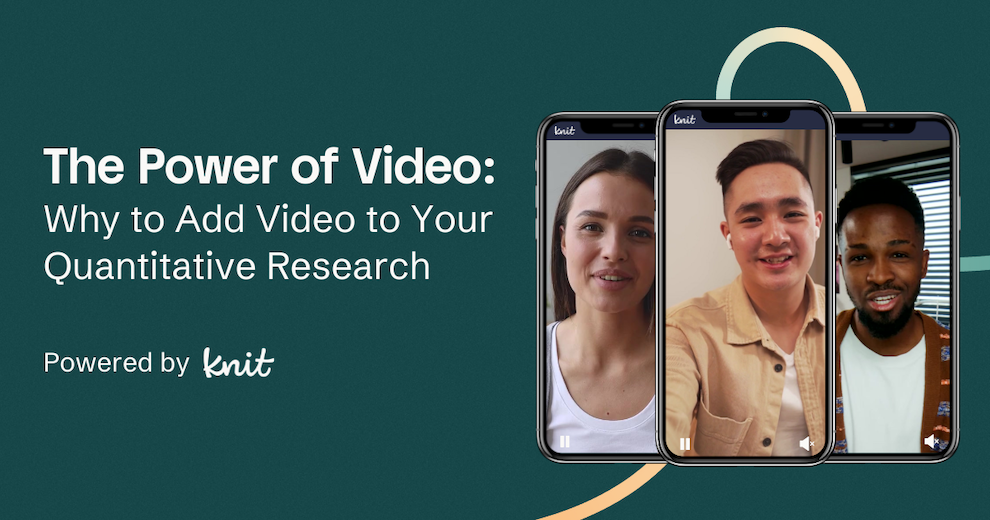By Aneesh Dhawan
 In today’s world, where data-driven decisions are the norm, integrating video into your quantitative research strategy can provide a transformative edge. Traditionally, quantitative research has relied heavily on numbers and statistical significance to inform decisions. However, video is emerging as a powerful tool to complement and enhance these data-driven insights.
In today’s world, where data-driven decisions are the norm, integrating video into your quantitative research strategy can provide a transformative edge. Traditionally, quantitative research has relied heavily on numbers and statistical significance to inform decisions. However, video is emerging as a powerful tool to complement and enhance these data-driven insights.
Integrating video into your quantitative research strategy offers substantial benefits that go beyond traditional survey data. By providing rich context, improving communication, capturing emotional and behavioral insights, and validating findings, video can significantly enhance the value and impact of your research. Embracing video as a complementary tool can lead to more comprehensive, engaging and actionable insights, positioning your business for greater success in an increasingly competitive market.
Here’s why adding video to your quantitative research can be a game-changer for your business.
The strategic advantage of integrating video into quantitative research
Enhanced context and interpretation
Quantitative research excels at revealing “what” is happening through numbers and patterns, providing a clear view of trends, frequencies and correlations. However, it often falls short of explaining the “why” behind these findings. This gap in understanding can limit the depth of insights derived from purely numerical data.
Video adds a critical layer of context that bridges this gap by capturing the subtleties of human behavior, interaction and response. Unlike static numbers, video can illustrate how consumers interact with products, react to marketing stimuli and articulate their thoughts and feelings. This visual and auditory information provides a richer, more nuanced understanding of the underlying factors driving quantitative trends.
A study published in the International Journal of Qualitative Methods emphasizes this point, highlighting that integrating visual and video data can significantly enhance the interpretation of quantitative results. According to the study, combining video with quantitative analysis helps to contextualize numerical data, leading to a more comprehensive understanding of consumer motivations and preferences. By observing and analyzing real-world interactions and emotional responses captured on video, researchers can gain insights that are not readily apparent from numerical data alone. This enriched perspective allows for more informed decision-making and strategic planning.
Increased engagement and comprehension
Video content is inherently more engaging than static data presentations, a fact supported by extensive research into digital content consumption. According to HubSpot’s 2024 research, visual content, including video, is 40 times more likely to be shared on social media compared to text alone. This significant disparity in sharing rates underscores the powerful role that video plays in capturing attention and driving engagement.
The increased engagement associated with video content can have a direct impact on the comprehension and retention of research findings. When data is presented through dynamic video summaries, it becomes more accessible and relatable. Videos can use visual storytelling techniques, such as animations, infographics and real-life examples, to illustrate complex data points in a more digestible format. This visual and auditory stimulation not only makes the content more memorable but also helps stakeholders grasp key insights more effectively.
Additionally, videos often evoke stronger emotional responses than text-based content. This emotional engagement can further enhance the retention of information. According to a report by Forbes, 95% of viewers remember a call to action after watching a video, compared to just 10% who retain this information after reading text. By leveraging these video advantages, organizations can ensure that their research findings resonate more deeply with their audience, leading to more actionable and impactful decision-making.
Effective communication of complex findings
Video content is inherently more engaging than static data presentations, and this increased engagement can have a profound impact on how research findings are communicated and understood. Unlike traditional text-based reports or spreadsheets, which often present data in a straightforward and sometimes dry manner, video introduces a dynamic element that captures viewers’ attention and makes complex information more accessible.
One of the primary reasons video content is so compelling is its ability to combine visual, auditory and emotional elements. Through animations, infographics and real-life footage, video can illustrate data in a way that is not only visually stimulating but also easier to comprehend. For example, a video summary of research findings might include animated graphs that highlight trends over time, while a voiceover provides a narrative that explains the significance of these trends in plain language. This multimodal approach helps break down complex concepts and makes them more digestible for a broader audience.
Moreover, videos can effectively utilize storytelling techniques to make the data more relatable. By incorporating real-life examples, case studies or testimonials, videos can contextualize numbers and statistics within real-world scenarios. This narrative approach helps viewers connect emotionally with the content, which can enhance their understanding and retention of the information. For instance, a video showcasing customer feedback and reactions can provide a more vivid picture of consumer sentiments than a chart displaying survey results alone.
Emotional and behavioral insights
These visual and auditory cues are crucial for understanding the full spectrum of consumer responses. Emotions such as excitement, frustration or satisfaction can be more clearly observed through video than inferred from quantitative data alone. For instance, while a survey might show a neutral average rating for a product, a video recording might reveal that while participants are verbally neutral, their body language and expressions convey frustration or disappointment. Such insights can help businesses understand the root causes of customer satisfaction or dissatisfaction that raw numbers might not fully reveal.
Moreover, video can capture contextual factors that influence consumer behavior. Observing how consumers interact with products in real-life settings can uncover environmental or situational variables that affect their responses. For example, a video might show how a product’s placement in a store or its packaging affects consumer decisions, providing insights that are not immediately apparent from sales data alone. This contextual understanding allows businesses to make more informed adjustments to product design, marketing strategies or customer service practices.
Video also enables researchers to gather detailed behavioral data. By observing how consumers use a product or navigate a website, researchers can identify patterns and pain points that quantitative metrics might not fully capture. For example, a video recording of users interacting with a website can reveal where they struggle or become frustrated, offering valuable insights into usability issues that could impact user satisfaction and conversion rates.
Enhancing quantitative research with video: Gaining deeper insights
Embracing video as part of your research toolkit can lead to richer insights, improved stakeholder engagement and more effective strategies. As the research landscape evolves, leveraging video to enhance quantitative analysis positions your business to better understand and respond to consumer needs, driving success and innovation in a dynamic environment.
Knit’s approach: Quantitative + video research
At Knit, we harness the combined power of quantitative and video data to provide a comprehensive view of your research needs. Our platform seamlessly integrates over 100 quantitative question varieties with VOC Video OE responses to ensure you can address both the “what” and the “why” behind your key questions. With Knit, you can swiftly gather hundreds of video responses within hours, delivering insights that are six times richer than traditional qualitative methods.
And don’t stress over the need to analyze (let alone watch) those hours and hours of video footage. Knit will analyze all of your qual data – summarizing findings, generating themes and subthemes, and visualizing it into digestible charts. Our no-code video editing and storytelling tools further enhance this experience, allowing you to easily clip, compile and share compelling customer stories and showreels. By bringing the voice of your consumer to life, Knit enables you to engage more deeply with your data and share impactful insights across your team. Experience the next level of research with Knit and turn data into actionable, dynamic stories – schedule your demo today.
